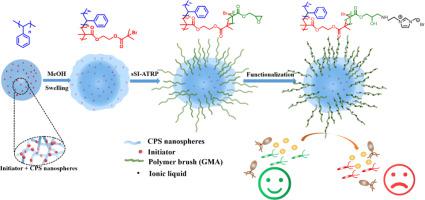Progress in Organic Coatings ( IF 6.6 ) Pub Date : 2022-07-26 , DOI: 10.1016/j.porgcoat.2022.107044 Biwen Wang , Peng Wang , Baoluo He , Shujuan Liu , Qian Ye , Feng Zhou

|
The chemical and biological characteristics of ionic liquids (IL) can be engineered via a suitable selection of their constituent anions and cations, which is instrumental in the research and the development of anti-biofouling materials. The ring-opening reaction and subsurface-initiated atom transfer radical polymerization (sSI-ATRP) were employed to prepare IL-functionalized polystyrene nanospheres effectively. The sSI-ATRP was used to graft the poly(glycidyl methacrylate) (PGMA) brushes onto crosslinked polystyrene (CPS) nanospheres while they were fully swollen. Subsequently, the imidazolium-based IL was bound onto PGMA brushes through ring-opening reaction between the epoxide groups of PGMA and the amine groups of IL. Furthermore, their anti-wear, antibacterial, and antifouling properties were comprehensively evaluated. Experimental results reveal that the as-prepared IL-functionalized PS nanospheres exhibited good antibacterial properties against both E. coli and S. aureus, attributable to the imidazole groups of IL, in addition to resisting adhesion of Porphyridium and Dunaliella. Moreover, the IL-functionalized CPS nanospheres manifested satisfactory wear resistance as against the traditional surface-initiated atom transfer radical polymerization (SI-ATRP), because the PGMA can graft on the surface and subsurface of the polystyrene nanospheres via sSI-ATRP. The as-obtained IL-functionalized polystyrene nanospheres can be mixed effectively with the self-polishing resin to acquire a novel self-polishing nanocomposite coating, the nanocomposite coating exhibit good antibacterial characteristics against E. coli and S. aureus, as well as a substantial antifouling effect against microalgae (83 % Porphyridium and 85 % Dunaliella were removed).
中文翻译:

离子液体功能化聚苯乙烯纳米球通过亚表面引发的原子转移自由基聚合制备用于防污应用
离子液体(IL)的化学和生物学特征可以通过适当的组成阴离子和阳离子进行设计,这在研究和开发抗生物燃料材料方面具有重要作用。采用开环反应和亚表面引发的原子转移自由基聚合(sSI-ATRP)有效地制备了IL功能化的聚苯乙烯纳米球。sSI-ATRP 用于将聚(甲基丙烯酸缩水甘油酯)(PGMA)刷子接枝到交联聚苯乙烯(CPS)纳米球上,同时它们完全溶胀。随后,基于咪唑鎓的 IL 通过 PGMA 的环氧基团和 IL 的胺基团之间的开环反应结合到 PGMA 刷上。此外,对它们的抗磨损、抗菌和防污性能进行了综合评价。E. coli和S. aureus,归因于 IL 的咪唑基团,此外还能抵抗Porphyridium和Dunaliella的粘附。此外,与传统的表面引发原子转移自由基聚合(SI-ATRP)相比,IL功能化的CPS纳米球表现出令人满意的耐磨性,因为PGMA可以通过sSI-ATRP接枝在聚苯乙烯纳米球的表面和亚表面。所获得的IL-功能化聚苯乙烯纳米球可以与自抛光树脂有效混合,获得一种新型的自抛光纳米复合涂层,该纳米复合涂层对大肠杆菌和金黄色葡萄球菌具有良好的抗菌特性。,以及对微藻的显着防污效果(去除了 83%的紫菜和 85%的杜氏藻)。



























 京公网安备 11010802027423号
京公网安备 11010802027423号